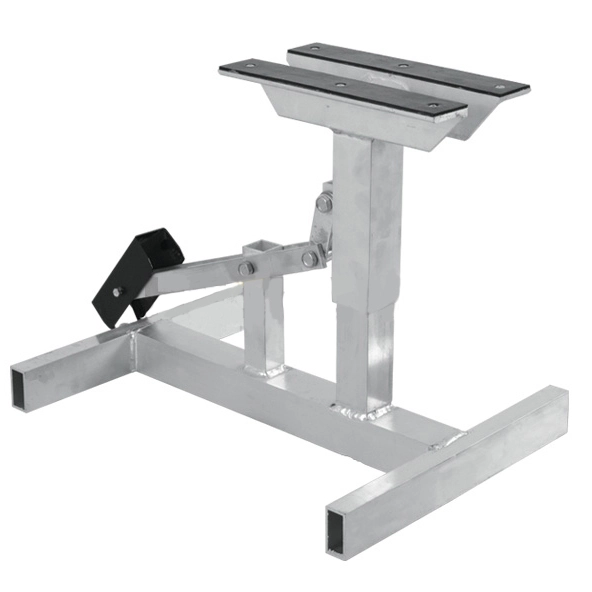Essential Safety Components of Motorcycle Lift Stands
Locking Mechanisms: Ensuring Stability at Height
One of the paramount safety features in any quality motorcycle lift stand is its locking mechanism. This critical component prevents unexpected lowering of the platform, which could lead to catastrophic accidents. Advanced lift stands utilize multi-point locking systems that engage automatically as the platform rises, providing incremental security at various heights. Some models incorporate redundant locking mechanisms, offering an additional layer of protection against failure.
The locking mechanism typically consists of heavy-duty pawls or pins that slot into corresponding notches or holes along the lift's frame. This design ensures that even if hydraulic pressure is lost, the platform remains securely in place. For added safety, many manufacturers include visual indicators that confirm when the locks are fully engaged, allowing users to proceed with confidence.
Anti-Slip Surfaces: Gripping Power for Secure Positioning
The interface between the motorcycle and the lift stand is a critical point of contact that demands special attention. High-quality motorcycle stand lifts feature anti-slip surfaces on their platforms and contact points. These surfaces are often made from textured rubber or specialized polymers that provide excellent grip even in the presence of oils or other fluids commonly encountered during maintenance.
Some advanced models go a step further by incorporating adjustable wheel chocks or tire cradles. These additions not only prevent the motorcycle from rolling but also distribute its weight evenly across the platform, enhancing overall stability. The combination of anti-slip surfaces and secure positioning elements ensures that your motorcycle remains firmly in place throughout the lifting and working process.
Weight Capacity Indicators: Preventing Overload Scenarios
Understanding and respecting the weight limits of a motorcycle lift stand is crucial for safe operation. To assist users in this regard, many modern lift stands come equipped with clear weight capacity indicators. These may take the form of prominently displayed labels, color-coded zones, or even digital readouts on more sophisticated models.
Weight capacity indicators serve as a constant reminder to users, helping prevent overload situations that could compromise the stand's integrity. Some advanced lift stands incorporate load-sensing technology that provides real-time feedback on the weight being supported, alerting users if they approach the maximum capacity. This feature is particularly valuable when working with multiple motorcycles or heavily modified bikes that may exceed standard weight expectations.
Advanced Safety Technologies in Modern Lift Stands
Hydraulic Safety Valves: Controlled Descent Protection
Hydraulic systems are the heart of many motorcycle lift stands, providing the power needed to elevate heavy bikes effortlessly. To enhance safety, manufacturers have integrated sophisticated hydraulic safety valves into their designs. These valves regulate the flow of hydraulic fluid, ensuring smooth and controlled descent even in the event of a sudden pressure loss.
The safety valves work by restricting the rate at which hydraulic fluid can exit the cylinder, effectively creating a fail-safe mechanism that prevents rapid drops. This technology is particularly crucial when lowering a motorcycle, as it guards against unexpected freefall that could damage the bike or injure the operator. Some high-end models feature adjustable descent rates, allowing users to customize the lowering speed to their preference or the specific requirements of different motorcycles.
Stability Enhancement Systems: Widened Base and Outriggers
Stability is a cornerstone of motorcycle lift stand safety, and manufacturers have developed innovative systems to maximize it. One such advancement is the implementation of widened bases and extendable outriggers. These features significantly increase the footprint of the lift stand, distributing weight over a larger area and reducing the risk of tipping.
Widened bases are often constructed from heavy-gauge steel and feature a low center of gravity, providing a solid foundation for the lift mechanism. Extendable outriggers, typically found on portable or mobile lift stands, can be deployed to create additional support points. Some models offer adjustable outriggers that can be fine-tuned to accommodate uneven surfaces, ensuring stability even in less-than-ideal workshop conditions.
Emergency Release Mechanisms: Quick Action in Critical Moments
In the rare event of a malfunction or emergency, the ability to quickly lower the motorcycle to a safe position is crucial. Recognizing this, manufacturers have incorporated emergency release mechanisms into their lift stand designs. These systems allow for rapid, controlled descent of the platform, independent of the primary lifting mechanism.
Emergency release mechanisms often take the form of large, easily accessible levers or pedals that can be activated with minimal effort. When engaged, they bypass the normal lowering procedure, utilizing gravity and controlled hydraulic release to bring the motorcycle down safely. Some advanced models feature remote-operated emergency releases, allowing operators to lower the stand from a safe distance if necessary. This feature provides an additional layer of security, particularly when working with unstable or damaged motorcycles.
Maintenance and Inspection: Ensuring Long-Term Safety
Regular Safety Checks: A Proactive Approach to Lift Stand Reliability
The longevity and reliability of a motorcycle lift stand heavily depend on regular maintenance and thorough safety checks. Establishing a routine inspection schedule is crucial for identifying potential issues before they escalate into safety hazards. Key areas to focus on during these checks include the integrity of welds and joints, the condition of hydraulic seals and hoses, and the proper functioning of all locking mechanisms.
Users should pay particular attention to signs of wear on load-bearing components, such as lift arms and support brackets. Any indication of metal fatigue, such as cracks or deformation, should be addressed immediately. It's also important to verify that all safety features, including emergency release mechanisms and anti-slip surfaces, are in good working order. By adopting a proactive approach to maintenance, motorcycle enthusiasts can ensure their lift stands remain safe and reliable for years to come.
Lubrication and Hydraulic Fluid Management: The Lifeblood of Smooth Operation
The smooth and safe operation of a motorcycle stand lift relies heavily on proper lubrication and hydraulic fluid management. Regular application of lubricants to moving parts such as hinges, pivots, and sliding surfaces reduces friction and wear, extending the life of these critical components. It's essential to use lubricants that are appropriate for the specific materials and environmental conditions of your workshop.
Hydraulic fluid, often referred to as the lifeblood of lift stands, requires special attention. Over time, hydraulic fluid can degrade or become contaminated, potentially leading to erratic operation or system failure. Periodic checks of fluid levels and quality, coupled with timely replacements as recommended by the manufacturer, are vital for maintaining optimal performance and safety. Some advanced lift stands feature transparent hydraulic reservoirs or fluid level indicators, making it easier for users to monitor and maintain proper fluid levels.
Documentation and Record-Keeping: Tracking the Lift Stand's History
Maintaining detailed records of your motorcycle lift stand's maintenance history, inspections, and any repairs or modifications is an often-overlooked aspect of safety management. This documentation serves multiple purposes, from helping identify recurring issues to providing valuable information for technicians during servicing.
A comprehensive record should include dates of inspections, notes on any observed wear or damage, details of maintenance procedures performed, and records of part replacements. This information can be invaluable for predicting when components might need replacement or when more intensive maintenance may be required. Additionally, in professional settings, maintaining such records can be crucial for compliance with workplace safety regulations and insurance requirements.
Conclusion
Motorcycle lift stands are indispensable tools for motorcycle maintenance, offering convenience and safety when properly used and maintained. By understanding and appreciating the various safety features explained in this guide, motorcycle enthusiasts can work on their bikes with greater confidence and security. Regular maintenance, coupled with a thorough understanding of your lift stand's capabilities and limitations, ensures that this crucial piece of equipment remains a reliable partner in your motorcycle maintenance journey. Remember, investing time in familiarizing yourself with these safety features and maintaining your lift stand is an investment in your own safety and the longevity of your motorcycle.
Contact Us
For more information about our high-quality motorcycle lift stands and their advanced safety features, please don't hesitate to contact us at info@runva.com.cn. Our team of experts is always ready to assist you in finding the perfect lift stand solution for your needs, ensuring your motorcycle maintenance is both safe and efficient.

_1737625693698.webp)


